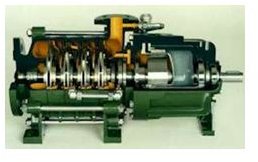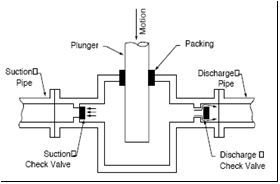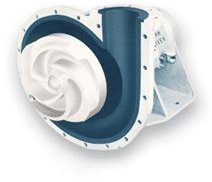What is a Pump? - Centrifugal Pumps, Displacement Pumps, Multi-stage Pumps
Pump Types and Operation
Introduction
A Pump is a mechanical device used to transfer liquids from one point to other by imparting energy supplied by a prime mover to the liquid. The prime mover can be an electric motor, an I.C. engine, or a steam engine or turbine. The power required to pump the liquid depends on the quantity of the liquid, the height (Head) to which it is to be lifted, and the viscosity of the liquid.
How Does a Pump Work?
A Pump works by imparting energy supplied by the prime mover, to the liquid, in two ways namely;
1. By imparting kinetic energy to the liquid by an impeller as in Centrifugal Pumps
2. By physically pushing (displacing) the liquid as in Displacement Pumps
Centrifugal Pumps work on the principle of Centrifugal Force acting on any mass when rotating. The liquid entering the eye of the impeller comes in contact with the rotating impeller, takes up the kinetic energy from it, and is acted upon by Centrifugal Force causing it to move towards the periphery of the impeller. On leaving the periphery of impeller, it enters the Volute Chamber or the Diffuser Vanes where its kinetic energy is converted into pressure. This pressure in the liquid causes it to move ahead in the pipes to its delivery point.

More than one impeller may be fitted on same shaft operating in similarly designed casing. Such Pumps are called Two-Stage, Three –Stage, or Multi-Stage Centrifugal Pumps.
Displacement Pumps are of mainly two types: Reciprocating Piston Pumps and Rotary Pumps. There are several variants in Reciprocating Piston Pumps. Similarly, there are several Rotary Displacement Pumps like Gear Pumps, Screw Pumps, and Vane Pumps. All the Displacement Type Pumps work on the same principle, i.e. by physically displacing the liquid by pump’s moving parts.
A Reciprocating Pump has a piston or plunger moving up and down via a crankshaft rotated by an electric motor. The top space above the piston is connected to suction and delivery pipes through suction and delivery valves. When the piston moves down, the suction valve opens and liquid from the suction pipe enters and fills the cylinder space above piston. Similarly, when the piston moves up, the liquid in the space above piston is pushed out through delivery valve into the delivery pipe.
When only space above the piston is used, the pump is called Single Acting Pump. However, the under side of the piston also can be fitted with suction and delivery valves, connecting to suction and delivery pipes and used as separate unit. The pump using both sides of the piston is called Double Acting Pump.

You can have more than one piston operated from the same shaft with more than one number of crank throws. Such a pump with two pistons is termed as Duplex Pump and one with three pistons is termed as Triplex Pump.
Rotary Type Displacement Pumps do not require Suction and Delivery Valves connecting to suction and delivery pipes as, the liquid is always pushed in one direction and there is no reversal of motion as in Reciprocating Pumps. All of the Rotary Displacement Pumps like Gear Pump, Screw Pump, Vane Pump etc. work on same principle: the liquid is trapped between teeth, threads, or vanes and is pushed from the suction side to the delivery side by rotating parts. Screw Pumps can have a Single Screw, Double Screw, or Triple Screw to work as multiple units.
